Photo Trip to Locatelli Meadow - Bonny Doon
July 19, 27, 31, 2006
I drove up to Locatelli Meadow on
July 18... only to find that after getting all set up, I didn't have the mount
plate for the GM8. Argh! The following night I made sure I had everything. It
was a quiet weekday night, with classical music on KBOQ keeping me company.
I did, however, have my first encounter with a mountain lion... a big one. Lurking
in that big oak tree next to our set-up turnout. I poked around during one of
the autoguided exposures and heard a growl and saw scat that looked and sounded
an awful lot like a lion. Five minutes later, a local resident drove by and
stopped and told me about the mountain lion she'd seen right there, not half
an hour ago. Hmmmm. So I kept my spare steel channel iron RA axis sleeve close
by for the remainder of the evening. My goal was a good long set of exposures
of Rho Ophiuchi / Antares and surrounding dark nebulae. Conditions were good;
no moon, and clear skies. A tiny bit of murk and the altitude by the time I
got set up was already getting low. I think that's why the blue color around
Rho Ophiuchi itself didn't come through well. It was HOT this night; temperature
was about 80F even at midnight. The CCD could only pull the chip down to -12C,
so residual noise is worse than usual.
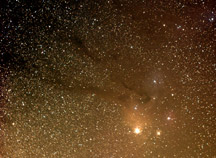
9x10min stack with the ST2000XCM
and 50mm Zuiko lens stopped down to f/4. I see some barrel distortion
around the edges; Perhaps f/5.6 will take care of that. No UV-haze filter.
Focus wasn't good, unfortunately. Clouds and low altitude marred all
but the first three 10min subframes. Now, it's an OK image, but with
a similar f/ratio and exposure time here
is what can be done with a top research-grade camera. I think we
can get more from our setup, in a better sky, focus, and higher altitude.
On the other hand,
this one was shot with very similar depth and looks a lot like mine
|

This stack has only the first
3 of the 9 images shown at left. The higher altitude and cleaner sky
of these three made for better contrast and less exticton of the blue
reflection nebulae, even if the overall signal/noise is not as high.
|

Single 10min shot. 50mm f/4
Zuiko lens + ST2000XCM around and north of the Lagoon Nebula. Unsharp
mask, levels in Photoshop.
|

M7 star cloud and the tail
of Scorpius, setting over the ridge above Locatelli Ranch. Single 2min
image 50mm f/4 Zuiko lens + ST2000XCM. The low altitude reddened the
stars.
|
My most important goal for this evening
was to evaluate the filters I'd just bought - the Orion Skyglow 2" filter,
and the Orion Ultrablock. The Skyglow lets in a fairly wide range centered on
H-beta and O-III in the blue/green, and also the H-alpha area, while blocking
the yellow/orange area which is where low and high pressure sodium street lights
emit, and also mercury vapor lights in the far green. However, they're advertised
as "not for astrophotography", yet with no explanation why. I thought
it worth a gamble and bought them; they can always be used visually on campus
with our 2" eyepieces in any event.
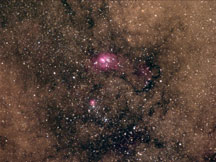
The Lagoon / Trifid Nebula
complex. This is with no filter; not even the usual UV-haze filter.
100mm f/1.8 lens stopped to f/4, 2x10min stack. No post-processing except
.jpg conversion at "62" quality.
|
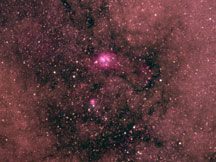
Same everything,
but with the Orion Skyglow filter, which lets in only the red and blue
(blue is preferrentially missing at this ~25 deg altitude?). |
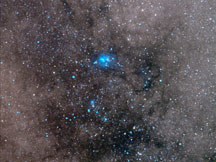
Same everything,
but with the Orion Ultrablock filter, which lets in only the blue/green
around O-III and H-beta. |
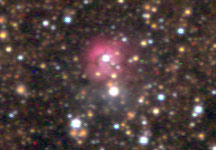
Above images, but zoomed
in on the Trifid Nebula, no filter and no post-processing except .jpg'ed
at quality=100 on full size version (click on the image)
|
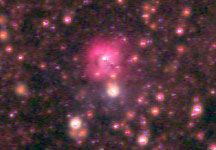
Same everything, but with
the Orion Skyglow filter.
|

Same everything but instead
with the Orion Ultrablock filter. Without the H-alpha bandpass, the
nebula looks pretty anemic. That's typical.
|
Conclusions: I'm
disappointed with the filters results. The higher noise is to be expected on
the filtered images above, but what I didn't expect is the rings of light surrounding
each star. Probably secondary reflections off the surfaces of the filters, which
apparently have no anti-reflection coating. The filters were loosely placed
on my lens; I do not yet have a 48-49mm adapter ring. Perhaps not being dead
perpendicular to the incoming light also hurt, but that appears to be a secondary
effect. The Trifid Nebula is a good test subject because it has both strong
H-alpha emission and also strong blueish reflection nebula on the lower side.
This bluish reflection nebula actually came out better on the unfiltered version
than in the Ultrablock version, which lets in blue/green light. The reflection
light is no doubt more strongly skewed towards shorter wavelengths which are
blocked. The Skyglow version looks like it has enhanced contrast in the red
H-alpha, but the poor star images are a killer.
July 27:
I did another photo night. Skies were a bit darker as fog rolled into Santa
Cruz sooner and the marine layer was deeper. It was also a cooler night, allowing
the CCD to cool to -25C.

The R Corona Australis
star formation region, and the globular cluster NGC 6723 (mag
7.3). 7x5min stack (35min) through the Megrez. Only 16 deg altitude.
Color rebalanced towards the blue in Photoshop as well as unsharp masking,
levels, and enhancement of both blue and red in Photoshop. This is a
dim nebula at low altitude. It needs more like 2-3 hours to begin to
do it justice. Note the speckled noise on the full size version.
|

The Dark Horse Nebula
in Ophiuchus. The hindquarters and back leg is also called the Pipe
Nebula. 3x5min stack (15min) with 50mm f/1.8 lens stopped to
f/4. Levels, unsharp mask, and color balance shifted towards blue to
correct for extinction/reddening.
|
July 31. For one
more night during this dark-of-the-moon period I drove up to Locatelli Meadow...
and found fog rolling over the pass. This is at 2200 ft elevation, so I retreated
to Andy's lot at 2650 ft - highest point on Bonny Doon. My goal was to shoot
"the Snake Nebula", but I had such a tough time trying to find the
darn thing. I even resorted to pulling up my "dark horse" picture
and zooming in and staring at it and the real sky, and I still couldn't get
the star patterns right. And it was setting. OK, it's 2:00am by now and I'm
NOT sacrificing a night's sleep for nothing. The Eagle Nebula - I thought I
could improve on my previous attempt. I got 40 minutes of integration, dozing
during each 5min exposure in the back of my RAV4, and listening to KBOQ playing
the Beethoven violin concerto and the Chopin Piano Concerto #1. Cool temperatures
allowed CCD chip to work at -25C. And, the final shot came out pretty well.
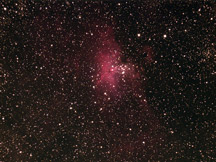
8x5min stack
(40min) on M16 (Eagle Nebula). 7/31/06, from Andy's Lot in Bonny Doon.
Levels, unsharp mask in Photoshop. No cropping. |

Same image, but cropped before
sizing and jpg'ing
|













